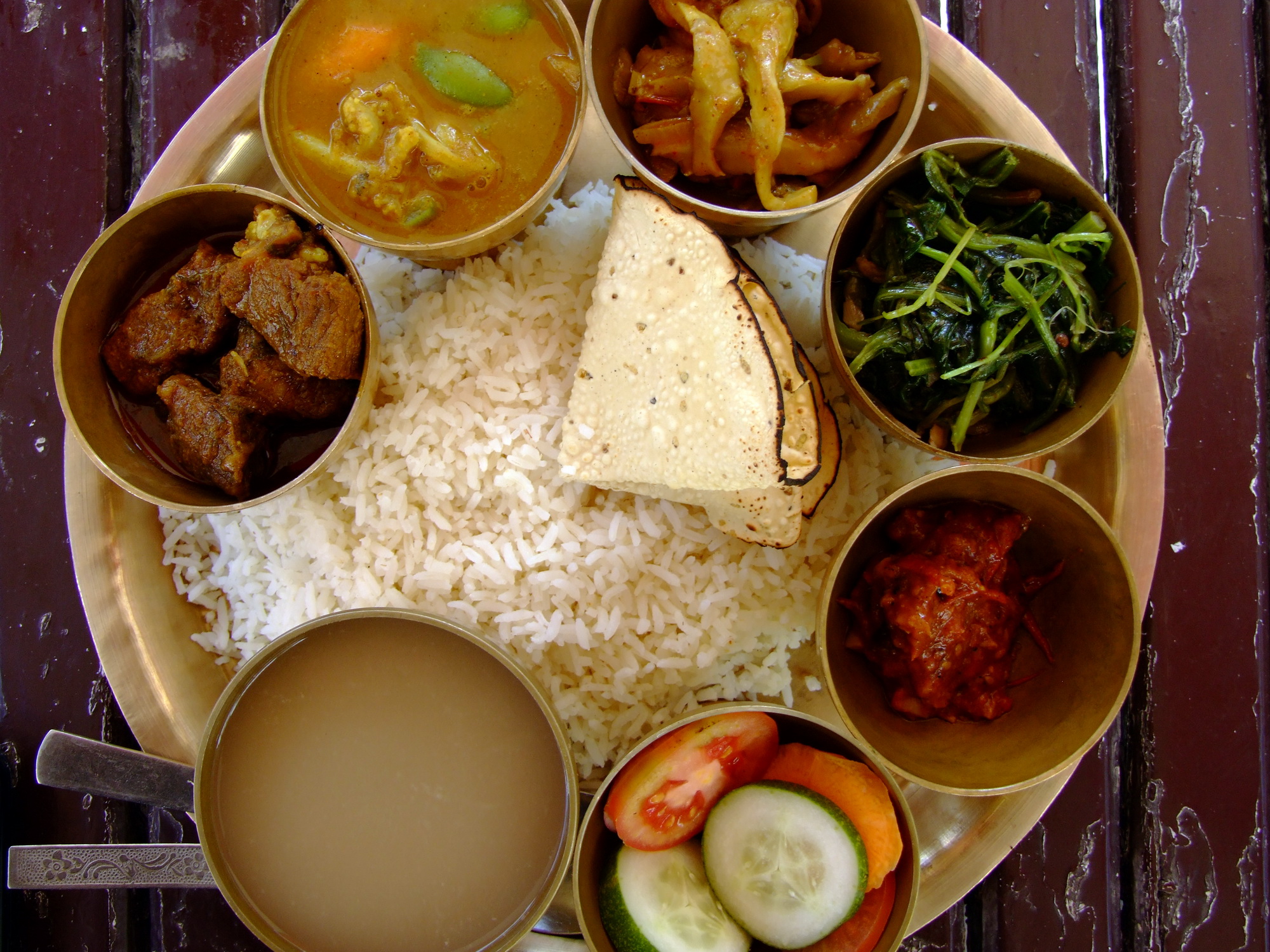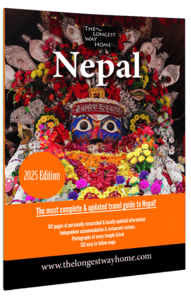

Dal Bhat is the most widely eaten dish in Nepal
It’s on every menu in every place that serves food in Nepal. The Nepali eat it two or three times a day, every day. It’s my favorite food in Nepal. It’s Dal Bhat!
As I wrote previous only what is the food like in Nepal Dal Bhat is Nepal’s staple dish. It is also known as Dal Bhat Tarkari, or just Tarkari (curry) in many local restaurants. Yet no matter the restaurant, cafe or hotel you order it in the chances are it will never be exactly the same. But usually always very good and very filling.
The main ingredients of Dal Baht are Dal (lentil soup) and Bhat (rice).
What is “Tourist” Dal Bhat made from?
Over the course of this series of food in Nepal I’ll introduce a few types of popular Dal Bhat that everyone encounters. In this case the Dal Bhat is very much the high-end tourist kind that comes with many additional extras.
The photograph of Dal Bhat above is “Mutton Dal Bhat”.
- Let’s start with the Green/brown bowl of liquid at the bottom and work clockwise.
- Dal, a soup made of lentils.
- Mutton cooked in chilli.
- Mixed vegetables consisting of cauliflower, carrot and green beans.
- Pickled vegetables.
- Spinach.
- Chili (very hot).
- A fresh selection of seasonal vegetables.
- In the center is white rice and papad.
Make your own Dal Bhat with these ingredients
There are many different subtle changes to Dal Bhat as you can see above. Here are the base ingredients in case you want to make your own.
To make the Dal:
- Dal or lentils 1 ½ cup
- Water 4 cups
- Salt to taste
- Turmeric ½ teaspoon
- Ghee (or oil)
- Asafetida (not essecital, see below)
- Cumin seed ½ teaspoon
- Garlic 1 glove – chopped
To make the Tarkari (curry):
- 1 Cauliflower – chopped
- 1 medium Potato – cubed
- 2 medium Tomato – chopped
- 1 cup Garlic – chopped
- Cumin (to taste)
- Coriander powder (to taste)
- Red chili powder (to taste)
- Salt to taste
- Turmeric ½ teaspoon
- Oil ½ cup (or as needed)
- Black pepper (to taste)
- Fenugreek seed ¼ teaspoon
Meats etc can be added to the Tarkari. Do note that Nepali Dal Bhat can be very spicy so take note of the “to taste”.
There are also Dal Bhat pre-made spices available in many stores. Though it would be better to get fresher spices in Ason Market during a heritage walk in Kathmandu.
How much does tourist Dal Bhat cost?
Great question. Keep in mind that this is a high-end meat version of Dal Bhat and a tourist version. Prices range from 400 rupees USD$4.85 upwards. I have come across some tourists paying in excess of 800 – 1,200 rupees in high-class hotel restaurants. I’ll cover the cost of average Dal Bhat and local Dal Bhat in later articles. Suffice it to say, they are a lot cheaper.
What does Dal Bhat taste like? (tourist version)
Fantastic. The rice is fluffy, the vegetables are fresh and the meat is tender. There’s usually far too much for one person to consume. And you should be really careful about the chili as it can be brutally hot. Usually there’s a small bowl of curd with Dal Baht to help with the heat.
If you do have a big appetite, or enjoy fresh food, then Dal Bhat is a great dish to try out when in Nepal.
Find out the best places to eat in Kathmandu:
- Best coffee shops in Kathmandu
- Cheap restaurants in Kathmandu
- Breakfast restaurants in Kathmandu
- Lunch restaurants in Kathmandu
- Dinner restaurants in Kathmandu
Looking for restaurants and places to eat great food in the rest of Nepal? Check out my guidebook below!
Get my Guidebook to Nepal & discover more than anyone else!
Looking for more insider tips and information like this? Get the most up-to-date, popular and dedicated guidebook to Nepal in the world. Over 617 pages & 984+ photographs of every temple listed, daily guides on all the treks listed and so much more.
Take a look below and you’ll find out why this beats all other guidebooks!


Yuuuuuuum!
I think I would enjoy it too as I’m the rice person, and I like to have rice accompanied with soup & gravy :)
I’m not a huge fan of plain rice, so mixing it with Dal or soup really works for me too :)
We were in Nepal a few years back. Dal Bhat was what we ate everyday when we went trekking. There’s nothing better to fill you up as you say.
We tried to recreate it back home and nearly got it as good. Maybe some of the spices were missing. A good reason to go back to Nepal though.
Maybe it’s Masala that’s missing?
This looks delicious! I love Indial dal so I bet I would like the Nepalese version too :) This looks like a standard thali from an Indian lunch menu here in NYC. And very vegetarian friendly (minus the mutton of course).
Yep, it’s one of the best vegetarian dishes available. Although Nepal does offer quite a lot of filling vegetable dishes compared to a lot of other developing countries.
Sounds like my kind of dish. I like my dhal hot!
I have to say, that looks absolutely perfect, for breakfast, lunch, or dinner.
Was about to say.. didn’t know it came with so many sides. But then you clarified. Daal bhat is my fave also.
Yep that’s the tourist version that you get lots of dishes. In the local, local version it’s just rice and dal.
As you know I am already a big fan of your Blog and today I actually got a chance to read some of your past writings. The food served in Nepal really looks like a fest compared to the food you have experienced in some of your past travels such as Africa and the burger stand in Iran :) Stay safe and healthy I enjoy the reading!
Wow, the burger stand in Iran … that’s going back a while. I still remember it. I’ll stick with Dal Bhat for now. Thanks!
In your sample photo of the dish, the rice looks undercooked. Somewhere in Indonesia, they said that undercooked rice can cause digestion problems.
Personally I prefer under cooked rice. Too much of what I ate in South East Asia was processed. In Nepal the rice mixed with Dal is very good. I’v never hear of anyone suffering from under cooked rice. I could imagine yes for non-cooked though.
When I was in Nepal we hardly ate dal bhat at all. I think we just found it too easy to eat more familiar food. I don’t even remember seeing anything that looked as good as your photo and in reading your description, I think I may have only seen the local version, as opposed to the “tourist” version with all the colorful sides.
That was almost 14 years ago. Now, my tastes have changed and I’d probably eat that every day if I were to go back. In this case, I think I’d prefer the tourist version too.
Yes indeed, there’s a huge difference between the local and tourist versions of dal bhat. I’m slowly going to move down the ranks of taste bud delight. I found the local dal to be very watery.
I was more of a “Momo” kind of girl – heck, I still am.
Momo’s will be on the way in all their glory.
the good looks so good! I never realized the importance of dal-bhaaat until i moved to USA. Gosh I miss dal-bhat
Hi Dave, I am from Kathmandu. Thank you a lot for writing about Nepal in such a detail. Here’s a little suggestion for you to update this article. If you go to local restaurants or hotels and ask for “Tourist Dal Bhat” they will kick you in the ass.
There is a name for this food you are calling “the tourist Dal Bhat”, it’s popular “Thakali Dal Bhat”. Thakali is caste in Nepal who are known for their version of Dal Bhat, and serving this food have been their family business since a long.
Please don’t call the local food as “tourist version” without knowing more about it, if any of you reading this are visiting Nepal and want to taste similar Dal Bhat, go to any Thakhali Food Place / Restaurant (there are all around Nepal) and order Thakali Dal Bhat, they serve (even better at some places) as in Dave’s picture.
You don’t need to call it “tourist dal bhat” to get it served. Know the local name and enjoy the food. The cost will be around 300NPR at max even in Lakeside. If you are eating the same Thakali “looking” food in star hotels you’ll billed around 800-1000 NPR but the food won’t taste as good as in Thakali Food Place.
Hi Bhupal,
I don’t think anyone reading this would go into a restaurant and actually ask by definition for “tourist dal bhat”. As you might have noticed I’ve also written about trekkers dal bhat. Again, I would hope no one would actually ask for “Trekkers Dal Bhat” while in a tea house trekking. Likewise I don’t think anyone would kick someones ass for doing so. It’s by virtue a description.
Much like Thakali Dal Bhat. Thakali come from the Mustang region of Nepal. If I went into a local restaurant in Kathmandu and asked for a Thakali Dal Bhat I may or may not get what you are describing. By virtue of asking for Thakali dal bhat and trying to save face a local cafe would probable do their best to put on a nice display. But it would indeed pale compared to the typical dal bhat served in a well established moderate restaurant.
Likewise the Thakali are by definition an ethnic group and not a caste per se. Though they do prefer to have an upper caste association.
Like many things in Nepal words get bent to suit a certain group. Newari Dal Bhat will one day don a tourist restaurants signage competing with a restaurant opposite it offering Thakali dal bhat … and so it will go on.